
The white-eyes are a family, Zosteropidae, of small passerine birds native to tropical, subtropical and temperate Sub-Saharan Africa, southern and eastern Asia, and Australasia. White-eyes inhabit most tropical islands in the Indian Ocean, the western Pacific Ocean, and the Gulf of Guinea. Discounting some widespread members of the genus Zosterops, most species are endemic to single islands or archipelagos. The silvereye, Zosterops lateralis, naturally colonised New Zealand, where it is known as the "wax-eye" or tauhou ("stranger"), from 1855. The silvereye has also been introduced to the Society Islands in French Polynesia, while the Japanese white-eye has been introduced to Hawaii.

The blackcap babbler is a member of the family Leiothrichidae. These are birds of tropical areas, with the greatest variety in southeast Asia.

The flamecrest or Taiwan firecrest, is a species of bird in the kinglet family, Regulidae, that is endemic to the mountains of Taiwan.
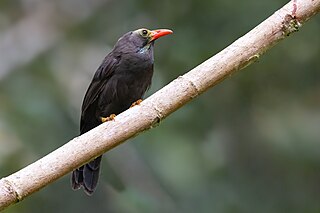
The bare-headed laughingthrush is a species of bird in the Old World babbler family Timaliidae. It is endemic to highland forests at elevations of 750–1,800 m (2,460–5,910 ft) in the mountain ranges of north-central Borneo, along with some outlying peaks. It is 25–26 cm (9.8–10.2 in) long, with both sexes similar in appearance. The head is brownish to greenish yellow and featherless. The area along the lower mandible has a bluish tinge. The rest of the body is dull blackish-brown tinged with grey. Juveniles have more feathers on the head, extending from the forehead to the crown.

The white-eared sibia is a bird in the laughingthrush family Leiothrichidae. The species is sometimes placed in the monotypic genus Malacias. It was first described by Robert Swinhoe in 1864. There are no subspecies.

The bar-throated minla or chestnut-tailed minla, or even bar-throated siva, is a species of bird in the laughingthrush and babbler family Leiothrichidae. Traditionally, it has been placed in the genus Minla but is now placed in Actinodura.
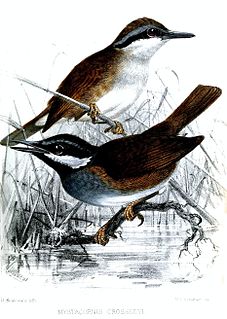
Crossley's vanga, also known as Crossley's babbler-vanga, Crossley's babbler, Madagascar groundhunter, or Madagascar groundjumper, is a bird species in the family Vangidae.

The fire-tailed myzornis is a bird species. Its genus Myzornis is monotypic, and has recently been placed in the family Paradoxornithidae.

The green shrike-babbler is a bird species that was earlier placed in the family Timaliidae. The species is now considered to be an Asian offshoot of the American vireos and belongs in the family Vireonidae.
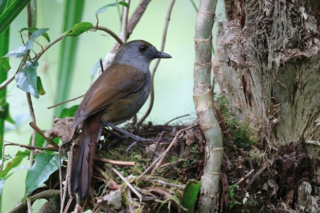
The Bagobo babbler or Bagobo robin is a monotypic species of bird with its taxonomy undergoing numerous changes and is currently classified as Muscicapidae or an old world flycatcher. It is endemic to the Philippines only found in Mindanao.

Yuhina is a genus of birds in the white-eye family Zosteropidae.

The striated yuhina is a bird species in the white-eye family Zosteropidae.
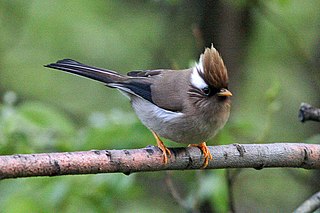
The white-collared yuhina is a bird species in the white-eye family Zosteropidae.

The whiskered yuhina is a bird species in the white-eye family Zosteropidae. Its range extends across the Himalayan forests in northern India to northeast Indian states, Nepal, Bhutan, Bangladesh and in the east to Indochina including Laos, Myanmar, Thailand, and Vietnam. Its natural habitat is subtropical or tropical moist montane forests. The whiskered yuhina is sometimes found in mixed hunting parties with other yuhina and fulvetta species, but it has also been reported to not associate with mixed hunting parties in some areas. It is described as one of the commonest yuhinas in the Himalayas, although it is relatively uncommon to rare at low elevations. It prefers relatively undisturbed closed canopy cover. It is one among several other birds hunted by livestock herders in Northeast India.

The stripe-throated yuhina is a bird species in the white-eye family Zosteropidae.
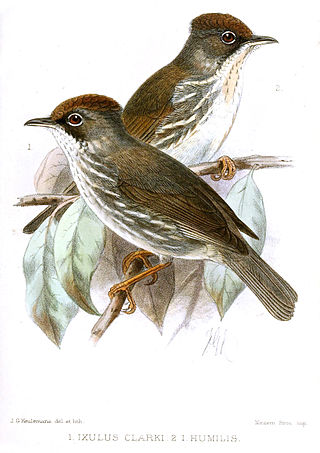
The Burmese yuhina is a species of bird in the family Zosteropidae. It is found in Myanmar and Thailand. Its natural habitat is subtropical or tropical moist montane forests.

The black-chinned yuhina is a bird species in the white-eye family Zosteropidae.

The white-bellied erpornis or simply erpornis is a species of bird. It is the only member of the genus Erpornis. This bird is found in Bangladesh, Bhutan, Brunei, Cambodia, China, India, Indonesia, Laos, Malaysia, Myanmar, Nepal, Singapore, Taiwan, Thailand, and Vietnam. Its natural habitat is subtropical or tropical moist montane forests.

Prunus campanulata is a species of cherry native to Japan, Taiwan, southern and eastern China, and Vietnam. It is a large shrub or small tree, growing 3–8 m (10–26 ft) tall. It is widely grown as an ornamental tree, and a symbol of Nago in the Ryukyu Islands of Japan. It is variously known in English as the Taiwan cherry, Formosan cherry, or bellflower cherry. It was described in 1883 by Carl Johann Maximowicz.

The African warblers are a newly erected family Macrosphenidae, of songbirds. Most of the species were formerly placed in the Old World warbler family Sylviidae, although one species, the rockrunner, was placed in the babbler family, Timaliidae. A series of molecular studies of the Old World warblers and other bird families in the superfamily Sylvioidea found that the African warblers were not part of Sylviidae but were instead an early (basal) offshoot of the entire clade Sylvioidea. Some taxonomic authorities place the entire family Hyliidae here.






















